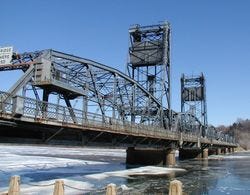A bridge for Stillwater

The Stillwater Bridge question is back in the news, with Governor Dayton and Representative Bachmann endorsing a new four lane bridge to connect to the future development in Wisconsin. Senator Franken is apparently undecided. Franken takes a bridge tour. MnDOT's information page is here The costs are quite high MnDOT estimates $633 M for a four-lane bridge.
We looked at the travel demands of the proposed Stillwater Bridge for MnDOT last year. The results are here. To summarize, we wrote:

"This report is prepared ... to assess the expected traveler impacts of replacing or not replacing the Saint Croix River Bridge in Stillwater, Minnesota. The model that has previously been used to evaluate different Lafayette Bridge replacement scenarios is applied, using the 20 county (“collar counties”) network from the Metropolitan Council and best estimates of 2010 land uses (population and employment). The model evaluates changes in travel cost due to network reconfigurations corresponding to different scenarios. These costs would need to be compared against construction and ongoing operations and maintenance costs, and do not account for factors such as travel time reliability, the value of a redundant network for planned or unplanned closures, or changes in land use.
It can be safely assumed that were a wider, faster bridge constructed there would be more development, and thus more travel demand from the Wisconsin side of the Saint Croix River. If no replacement bridge were built, we can assume that less growth (if any) would occur, and cross-river traffic would diminish. This model does not account for changes in land use, as we do not believe this has been accurately forecast for scenarios both with and without the bridge, but does account for changes in demand given the current land use under different network configurations. This is denoted as “Variable Trip Tables” in the report.
Compared to the baseline (a replacement 2 lane bridge in the same location) according to the model, Construction Alternative 1, a new 4 lane bridge, produces an economic gain of $1.8 million per year.
Compared to that same baseline, Construction Alternative 3, no replacement bridge at all, results in an economic loss on the order of $34.1 million per year according to the model."
Again, this comes down both to Benefit / Cost analysis (does this pass a test?) and priorities (does this count as "Fix It First"?). I think building a four lane bridge to replace a two lane bridge does not fully count as "preservation", but rather as "expansion". Given the state of the network, and the need to give priority to preservation, a four lane bridge violates that principal. As to whether a four lane bridge passes a B/C test, or better yet, a market test of whether a private firm would build it, the answer is clearly no. This four-lane bridge would not have enough demand to pay the tolls required to fund it. That should tell you something about its true necessity. The Franken article cited above suggested Wisconsin wasn't interested in funding it. Since the majority of benefits for the bridge accrue to Wisconsin land owners, it makes no sense for Minnesota to lead on this.

